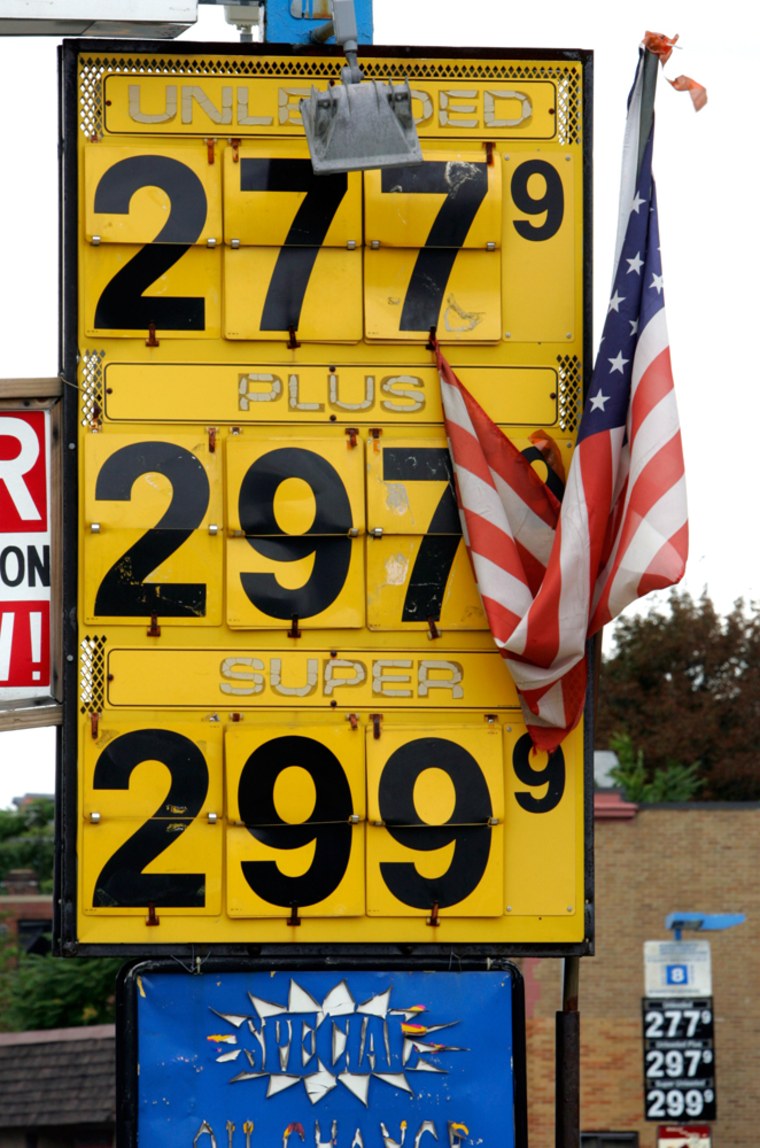After marching relentlessly higher this year, gasoline prices suddenly have made a sharp U-turn in the past few weeks. And analysts say consumers can expect even more relief at the pump in the coming weeks.
“Wholesale prices are down 70 cents since Aug. 7, and retail are down about 30 cents,” said Tom Kloza at Oil Price Information Service. “It doesn’t take John Maynard Keynes to anticipate that we’ve got tens of cents of catching up to do.”
The average retail price for a gallon of regular gasoline fell 11.8 cents last week to $2.73 per gallon, according to Energy Department figures released Thursday. That's 34 cents lower than this time last year and the lowest level since April.
And gasoline inventories continued to build, making it likely the pump prices will continue to drop. Refineries are running at 93.6 percent of capacity — the highest levels since hurricanes Katrina and Rita took a big bite out of production last fall.
Prices are dropping so fast that in some Gulf Coast markets gasoline costs less than the crude oil it takes to make it, said Kloza.
"I think we'll quickly see prices move to $2.50 on a national average and may go as low as $2.25," said John Kilduff, an oil analyst at Fimat USA.
Just as the sharp spike in pump prices this year had multiple causes, several factors have combined to send prices lower again.
Much of the price run-up was based on fears that gasoline producers, still recovering from refinery damage inflicted by last year's hurricanes, would have trouble keeping up with the annual rise in demand for the summer driving season. Those fears were amplified by bottlenecks early in the season caused by a switch to a seasonal ethanol blend.
A lot of the supply fears concerning the use of ethanol really didn’t come to fruition,” said Kilduff. “We made it through the peak driving season.”
In fact, there’s something of an ethanol boom under way. Though ethanol still costs more than gasoline, production has increased rapidly this year, and more than a dozen companies are investing in new plants that will double total output by 2010 to 10.6 billion gallons, according to Friedman Billings and Ramsey analyst Jacques Rousseau. (Last year, American drivers burned through about 140 billion gallons of gasoline.)
Gas prices also have retreated recently as speculators who poured investment into futures contracts earlier this year have started pulling their money out. That retreat was sparked last month when the widely watched Goldman Sachs Commodity Index cut back on its weighting for gasoline futures.
Traders had also bid up gasoline futures on fears that another nasty hurricane season could repeat the refinery damage and supply interruptions brought by Katrina and Rita last year. So far those fears have turned out to be overdone.
“There’s excitement that the hurricane season hasn’t been worse,” said Peter Beutel, an oil analyst with Cameron Hanover. “And as a result, a lot of people who bought (gasoline futures) anticipating the hurricane season have started to liquidate.”
Consumers are finally getting some relief.
The biggest drop has come in the Midwest, where the average pump price fell 16.5 cents last week to $2.60 a gallon. Diesel fuel prices also are down, falling 6 cents nationwide to an average $2.97 a gallon.
Kloza figures Americans will spend some $3 billion less on gasoline this month than they did last September. Beutel estimates consumers will save another $3.8 million a day for every penny knocked off the average pump price.
So just how low can pump prices go? On that question, analysts are all over the map. But they agree on one point: Gasoline prices aren’t likely prices to fall back below $2 a gallon unless the price of the crude oil from which it’s made also drops significantly.
“It’s difficult to really make a strong compelling case for crude price to drop unless A, you have a recession or B, you have peace, love and happiness break out in all of these chaotic portions of the globe,” said Kloza.
Major oil producers like like Iran and Venezuela have made clear they want to prevent crude prices from falling. And oil production in Iraq, and to a lesser extent Nigeria, has been slowed by violence and insurgent attacks.
“We’re going to need some of the uncertainty in the oil-producing countries to be rectified (before oil prices fall),” said Kilduff.
But over the longer term, some analysts believe that the high price of crude oil is having the effect that economics textbooks predict it should: spurring development of new oil supplies. Recent test wells in deepwater Gulf of Mexico — from holes drilled through five miles of rock at sea depths of over 9,000 feet — have raised hopes of the biggest U.S. oil discovery since the Alaskan North Slope in the 1970s.
“This is going to be going on all over the planet,” said Beutel. “At $70 a barrel you could probably find oil in your own back yard. You’d just have to dig awfully deep.”
Beutel says that over the next five years or so increased drilling activity worldwide could send oil prices crashing — and pump prices as low as $1 a gallon in some parts of the country.
But that forecast is on the optimistic end of the range. While consumers may once again see pump prices below $2 a gallon, most analysts expect pump prices to remain volatile.
“My bet is that the market is going to continue to be extraordinarily bipolar,” said Kloza. “And the difference between the lowest price you pay in any calendar year is going to be more than a dollar. And that could mean $1.75 to $3.50.”
